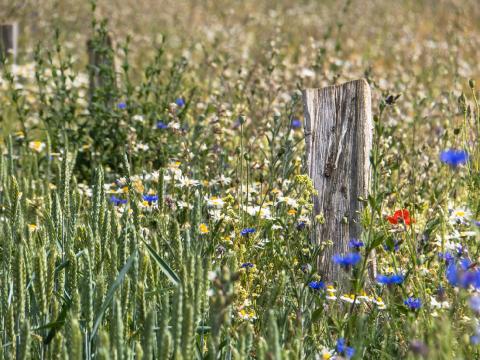
Flower Strips in Crop Diversification Systems Encourage Biodiversity and Biological Control
May 23 2023Since 2018, faculty and research staff from the Agronomy, Forestry, Water and Environmental Sciences and Engineering Department (SIAFEE, run by the Agronomy and EcoSys Joint Research Units) and the Life and Health Sciences Department (SVS, run by the ESE Joint Research Unit) have been assessing the quantitative effects of a variety of large-crop production methods and the use of flower strips on biodiversity and the associated regulating services. Across a network of farming plots owned by 32 farmers in the Centre and Greater Paris regions of France, various organisms are regularly monitored, including mesofauna, macrofauna, and birds, to evaluate the relationships between the regulation of crop-destroying insects and soil fertility. Three videos were produced to promote this project, and the initial results can be accessed on the Agronomy Joint Research Unit’s YouTube channel.
Flower strips in Crop-Diversification Systems: Two Drivers for Agroecology
Over the course of several decades, a drop in the number of birds and certain species of insects has been observed in French farming areas and, more generally, across Western Europe. This collapse represents a threat to some ecosystem services supplied by this highly specific biodiversity, both to society in general and to farmers, especially in terms of soil fertility and the control of crop-destroying insects.
While some alternative systems have received positive press and been adopted by some farmers (elimination of pesticides, development of agroforestry, etc.), there is still room for improvement when it comes to biodiversity. This, in any case, was the starting point used by the project’s researchers, who, with the help of a group of farmers, are studying how planting strips of flowers on the edges of fields can have an effect on biodiversity. A total of approximately forty varieties have been planted (with potential for year-round flowering), with specific monitoring in place for each plot. This should help us better understand the resources and the safe havens of the living organisms that can thrive in this environment.
Soil Biodiversity and the Decomposition of Organic Matter
What are the effects of large crop systems and flower strips on diversity, how the agroecosystem works, and the ecosystem services provided? To help us understand, let’s take a closer look at the key players: the living organisms present in the soil and the decomposition of organic matter. If you examine soil more closely, you will find bacteria and fungi, as well as all the fauna that grows there: first microfauna (e.g. nematodes or roundworms), then on a larger scale, mesofauna (e.g. mites, springtails), then on an even larger scale, macrofauna (e.g. earthworms, millipedes), and, lastly, megafauna (rabbits, moles, rodents, etc.).
The quality of ecosystem services is dependent on the richness of the biodiversity. These include improvements in the regulation of water, recycling of organic matter and significant structuring of the soil.
The Contribution of Flower Strips to the Control of Crop Pests
Studying the effects of different large-crop production methods and flower strips on biodiversity and the associated regulating services is also about taking a closer look at things that can pose a problem to crops. Crop-destroying insects are one example. According to Antoine Gardarin, the chief scientist on this study, the way we deal with insects that attack crops can no longer rest solely on the use of chemicals, as is usually the case at the moment, due to the impact this has on biodiversity and human health—not to mention technical hurdles such as pesticide resistance. Alternatives need to be put in place.
It is for this reason that the researchers involved in the study are working on developing a biological control method through the protection and management of habitats. This consists of encouraging control by introducing predators and parasites to target crop-destroying insects, as well as by adapting practices and land use on and near plots of land to naturally encourage the auxiliary services that help to regulate insects in the adjacent crops.

